|
Applying the Expectancy Theory to
Explain the Motivation of Public Sector
Employees in Jordan

Mira Nimri
Aya Bdair
Hamzeh Al Bitar
Department of Business Administration,
King Talal Faculty of Business and
Technology,
Princess Sumaya University for Technology,
Amman, Jordan

Abstract
The purpose of this research is to
examine the motivation of public sector
employees in Jordan. A modified model
of Vroom's expectancy theory, which
includes five components: expectancy,
extrinsic instrumentality, intrinsic
instrumentality, extrinsic valence,
and intrinsic valence is adopted and
applied to 258 employees of 13 public
sector institutions in Amman. It remains
to be seen in what extent do intrinsic
and extrinsic factors motivate employees
and how should managers incorporate
strategies in order to make sure that
the rewards are answered with increased
productivity.

Introduction
The Hashemite Kingdom of Jordan has
been facing a number of serious problems.
Since its independence in 1946, it
has suffered from several wars, a
lack of natural resources, and multiple
refugee crises. The recent turbulences
that resulted from the Arab spring
have also had a great economic impact
on the country, such as an overload
of refugee capacity and a negative
effect on tourism. Unfortunately,
all these problems that hindered progress
and development could not be controlled.
However, one of the main problems
that impact the country is one that
is fully within control yet seems
impossible to solve, that is, public
sector performance. Standing at a
rate of over 40% of total employment
with approximately 225,000 employees,
it is clear that one of the first
noticeable problems is over-hiring
with continuous decline in the quality
of services. This causes a long list
of serious problems affecting government
performance.
In an effort to reduce unemployment,
which as of mid-2014 stands at 12%,
the government employed 12,000 people
annually during the past few years.
This has led to serious problems of
burdening the government financially
as well as increasing the gap between
employees' knowledge and the skills
required for their jobs, all in all
leading to decreased productivity.
There have been
serious efforts to improve performance:
through civil service system reforms,
increasing motivation with awards
such as the King Abdullah II award
for excellence in government performance
and transparency (initiated ten years
ago) and International Organization
for Standardization (ISO), which hopes
to also boost creativity in the public
sector, an element that is severely
lacking. However, there's still not
enough improvement.
Although progress has been witnessed
in certain departments, such as Drivers
and Vehicle Licensing Department,
and the Department of Civil Status,
most ministries and public sector
institutions are still suffering from
low quality services and administrative
flabbiness. The civil service system's
latest reforms should in theory motivate
employees to perform better. Among
the reforms made, there have been
several that addressed rewards for
performance.
Such a reform was an amendment to
article 76 which used to limit the
number of times an employee could
be upgraded based on merit removed
the limit, which should increase performance
and competitiveness. It is worth mentioning
that merit upgrading is based on the
employee's annual evaluation for the
last 5 years (last 2 years: Excellent,
the 3 years before: Very good) and
a clean record (no disciplinary action
taken against him/her).
Another important amendment is that
now employment is by contracts, thus
lowering the feeling of absolute job
security that makes some employees
less productive. Now an employee has
to uphold a certain level of performance
to ensure he or she is not fired.
An amendment that truly addresses
the personal and professional development
of the employees is an amendment which
states that any employee that acquires
a new educational qualification (for
example: a bachelor's degree) will
receive an increase in annual bonuses.
Other changes that in general aspire
to improve overall performance and
human resource practice include downgrading
the penalties so they start with a
warning instead of a direct deduction
from the annual bonus; this aims to
genuinely control and improve employee
behavior instead of immediately penalizing
them. They also expanded the authority
of the secretary general of each institution
to include addressing and adjusting
the conditions of the institution's
staff, changed the name of the employee
committee to the human resources committee
and added to its attributes human
resource planning and management.
In addition to that, they canceled
the bonuses committee and added its
tasks to the human resource committee.
And in an effort to control the bloated
government they set the maximum number
of supporting jobs at 30% of total
jobs.
It is clear that the civil service
system does have rewards for those
that work hard and perform well. That
has been the case even before the
newest reforms, yet that does not
show in performance. So it is necessary
to see how employees perceive these
rewards to understand where their
motivation stems from. Another important
factor to consider is the personal
motivation of public sector employees,
and how they see their own personal
and professional development in their
public sector careers.
It is essential to understand how
the employees perceive their work
and the rewards they receive for it.
One theory that could explain this
is the Expectancy Theory (Vroom, 1964).
The expectancy theory explains how
the motivation force is formed by
examining the employees' perception
on three levels:
1. Expectancy, which
addresses how employees see the effort
they put into their job affects their
performance.
2. Instrumentality, which explains
how employees view potential rewards
for their performance.
3. Valence, which shows the
value employees place on those rewards.
Since there is huge concern over public
sector performance and its negative
impact on the country, it is critical
to examine the problem with a scientific
approach. There are many elements
in the complex equation to enhance
performance and productivity, and
in this research we choose to focus
on only one: public sector employee
motivation.
Literature Review
Vroom's expectancy theory of motivation
(1964) attempts to explain the reason
behind employees' motivation through
understanding the perception the effort
put into work to the reward they receive
in return. It is composed of three
factors, as follows:
Motivation force = Expectancy x Instrumentality
x Valence (i.e. VIE model)
The expectancy theory suggests that
employees will be motivated to work
harder if they believe their effort
will result in good performance, and
that performance will lead to a reward,
and that reward will satisfy a need
worth the effort (See figure 1). Each
of those beliefs is represented by
a factor:
Expectancy: refers to an employee's
perception of the effort's role in
improving performance. This is determined
by self-efficacy, goal difficulty,
and perceived control. Self-efficacy
is an employee's self-assessment of
their capability to perform a task,
goal difficulty affects the employee's
perception of the attainability of
the goal (the more difficult a goal,
the less the expectancy), and the
perceived control of the job which
leads to an employee's development
of ownership and responsibility thus
leading to higher motivation.
Instrumentality: refers to
an employee's belief that good performance
will lead to a reward (could be tangible
or intangible). It is composed of
three variables, trust, control, and
policies; trust in who decides the
reward and it's receiver, control
of the decision making process in
case there is no trust, and policies
that clearly state how performance
will lead to reward.
Valence: The value of the reward
in the eyes of the employee. This
is determined by the needs, goals,
values, preferences, and sources of
motivation of the employee.
Based on a combination of all three
factors, employees will choose the
behavior alternative that gives them
the highest motivation force. The
higher each factor, the higher the
motivation. So, the theory is dependent
on perception; perception of effort
and performance, and performance and
reward, as well as the perception
of the value of the reward. Therefore,
the expectancy theory could be considered
a "process theory" (Fudge
and Schlacter, 1999) as opposed to
a content theory, since it depicts
how expectations lead to one behavior
or another depending on the individual's
perceptions.
Figure 1: Vroom's Expectancy Theory
Model

Criticism of the Expectancy Theory
Despite its popularity and general
acceptability, the expectancy theory
has not had enough empirical evidence
to validate it. It has been criticized
by many scholars; however the criticism
has not been a full rejection of the
theory, rather an extension to make
up for its weaker points. This has
led to various developments of the
theory by several researches who integrated
other elements into the equation.
The first generation of critics included
Graen (1969), Lawler (1971), and Lawler
and Porter (1967). Their main concern
was that the theory was too simple.
They did not believe it could accurately
predict an employee's increased effort
as a response to a reward. For example,
the reward might be a promotion, but
if that means more working hours,
then the employee might not place
high value on it, and so will not
put more effort. Lawler and Porter
also presented a modified version
of the theory to include extrinsic
and intrinsic factors (see Figure
1).
Landy & Becker (1990) suggested
that the key to improving the predictions
of the expectancy model might lie
in variables such as the number of
outcomes, valence of outcomes, and
the particular dependent variable
chosen for study.
Schwab (1979) examined the relationship
between the VIE model and two criterion
variables, effort and performance.
They included several moderators of
this relationship in 32 between-subject
studies in a statistical analysis.
Van Eerde & Thierry (1996) used
meta-analysis to examine the theory's
factors and their relationship to
five types of criterion variables:
performance, effort, intention, preference,
and choice. Campbell & Pritchard
(1976) argued that these set of variables
are too complex and poorly misunderstood
to be encompassed by a simple equation.
Starke & Behling (1975) did not
find that people made decisions related
to work effort in a manner consistent
with the axioms underlying the expectancy
theory: independence and transitivity.
To sum up, research has found that
the expectancy theory has proved its
worth, however not without an overwhelming
percentage of modified forms of the
theory. (Lawler, 1973)
Figure 2: Lawler and Porter's modified
expectancy theory, 1967
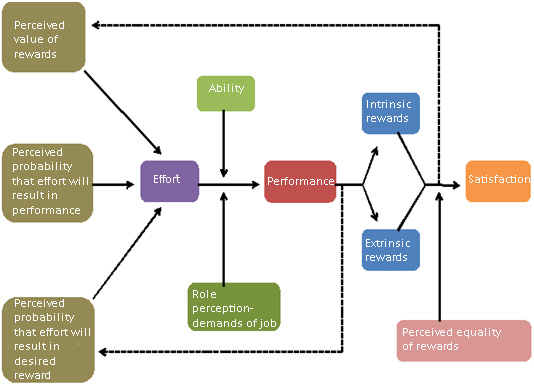
Motivation in the Public Sector
(Extrinsic/Intrinsic)
The research on motivation of public
sector employees has been growing
steadily for the past 40 years, yet
continues to severely lack consistency.
The general conclusion is that employees
are motivated through extrinsic rewards
(rewards provided by others such as
salaries, promotions), intrinsic rewards
(rewards that stem from the individual
such as satisfaction, feeling of accomplishment),
and public sector motivation (feeling
of responsibility and duty towards
the society). However, whether public
sector employees are more influenced
by one kind of reward or another is
still unknown. The debate has not
been conclusive, since many studies
are suggesting one configuration and
others are contradicting it completely.
Extrinsic rewards
Research regarding the extrinsic reward
of job security and promotion has
not been consistent. The research
ranged from evidence claiming public
sector employees value job security
less than the private sector employees
(Crewson, 1997) to other evidence
suggesting they value it more (Baldwin,
1987), to finding no difference between
the two sectors (Wittmer, 1991; Gabris
& Simo, 1995). As for promotion
of status and prestige, some research
found that it is less important for
employees of the public sector (Crewson,
1997), while other research found
there's no difference when they compared
the two studies (Wittmer, 1991; Gabris
& Simo, 1995).
Intrinsic rewards
The same contradictions have been
found in research on intrinsic rewards.
While it's been found that public
sector employees valued the feeling
of accomplishment and self-worth more
than private sector employees (Crewson,
1997), it's also been concluded that
they are not motivated by responsibility
and self-development (Buelens &
Van den Broeck, 2007). Another research
found that public-sector employees
don't place as much value on autonomy
and ability to work independently
as those in the private sector. A
more recent research found that there's
no specific difference across sectors
regarding having an interesting job
as a motivator (Houston, 2011).
Public Service Motivation
Public Service Motivation (PSM) is
a concept developed by Perry &
Wise (1990). Perry's research concluded
that public service employees, in
contrast to their private sector counterparts,
are motivated by their civic duty
and responsibility.
There is a lot of empirical evidence
to support Perry's statement, suggesting
that public employees are less motivated
by extrinsic rewards than the private
sector employees (Solomon, 1986; Wittmer,
1991). The presence of PSM and its
value for public sector employees
is also evident from research that
suggests employees of the public sector
are more willing to volunteer and
donate blood than the private sector
employees (Houston, 2006).
Further discussion on extrinsic/intrinsic
work motivation in the public sector
There is an overwhelming general belief
that public sector employees are motivated
intrinsically than extrinsically,
however research has mainly focused
on PSM as a representation of intrinsic
rewards. Because of this, the intrinsic
rewards of self-accomplishment and
self-worth, work independence and
autonomy, and self-development have
been somehow neglected in the literature.
Studies examining the pay-for-performance
and other financial incentives and
rewards concluded a "crowding
out effect", that is extrinsic
rewards actually decrease intrinsic
(PSM) motivation (Frey, 1994).
Other research simply points out to
the individual differences. Delfgaauw
& Dur (2008) suggest that public
sector employees could be divided
into three categories: lazy, regular,
and dedicated. Lazy employees avoid
putting effort into their jobs; dedicated
employees are motivated by PSM, while
regular employees are the same as
the dedicated ones but without the
PSM. Each category of employees has
different motivations, especially
when taking into consideration if
the effort is verifiable or not. Delfgaauw
& Dur (2008) found that lazy employees
prefer jobs where effort is unverifiable,
while on the opposite, dedicated employees
prefer effort that is verifiable.
Research has found that in countries
facing economic challenges and high
rates of unemployment, the public
sector is preferred as it provides
job security and stability (Boudarbat,
2008; Groeneveld et al., 2009). It's
also been found that the higher the
wages paid by the public sector, the
more the job attractiveness increases
(Adamchik & Bedi, 2000; Tansel,
2005).
Countries that have a career-based
system provide better job security
than position-based ones. In a career-based
system, employees are expected to
work their entire lives in the public
sector, promotions and career advancements
are decided by the government and
the labor market is internal. Whereas
position-based relies more on competence
regardless of their existence inside
or outside the public-sector labor
market, that is they don't mind bringing
in external employees to switch and
start work in the public sector (Hammerschmid
et al., 2007).
Research has found that the lower
the income, the higher the preference
for public sector work for its job
security. In opposite to income, research
found that the higher the educational
lever, the less the preference for
public sector. As for age, older people
have been found to prefer public-sector
work more than younger generations
(Van de Walle, et.al, 2014).
Jordanian Public Sector Employees
While having public sector employees
rank intrinsic rewards higher than
extrinsic might seem like a good thing,
it might actually be a symptom of
a serious problem. If considered within
a Jordanian context, this could be
due to the fact that performance is
not directly related to an increase
in income or promotion. Employees
have very little trust that their
hard work would be rewarded. They
do not believe their original salary
is proportional to the work they do,
or that it is enough to satisfy their
needs. They also do not believe that
the promotion system is fair, or that
they would be rewarded financially
in any manner if they are more productive.
An even more serious problem is that
the same study also found that there
are overwhelmingly low moral incentives
as well. The employees do not believe
the government cares enough about
its employees' professional well-being;
the government does not provide medals,
honorary promotions, advantages for
participating in training courses,
participation in decision making,
transfer to another position for better
utilization of skills, and transfer
to a better department as a reward
for good performance.
However, in terms of the social incentives
provided by the government, the results
were significantly higher. Employees
found availability of a daycare center
and a room for prayer highly motivating.
Being provided with cultural services,
such as a cultural or sports center
as a reward for good performance,
lead to medium motivation, whereas
loans for social occasions, compensation
for transportation costs, and availability
of a cafeteria were found not to contribute
to motivation.
The study also found that the overall
performance of the employees is average.
The study looked at different aspects
of performance, such as: willingness
to work outside official work hours,
ability to solve work problems, ability
to act in critical situations, full
readiness to take responsibility,
commitment to work laws and procedures,
participation in management decision
making, possession of good communication
skills, constant performance improvement,
completing tasks according to the
required standards, and performing
work as effectively and efficiently
as required.
So, as concluded from the study, public
sector employees perceive social incentives
as their first motivator, followed
by moral ones, and finally financial
ones in Jordan.
Unfortunately, there has not been
sufficient literature regarding the
motivation of public sector employees.
Methodology
Our main goal is to address many
of the concerns stated in the previous
section in one holistic model. In
order to do that we adopted a research
design similar to that of Chiang and
Jang (2008). While their research
applies a revised model of the expectancy
theory to hotel employees, we want
to use it for the public sector employees
in Jordan. We believe that for the
particular contingency of the sector,
the model is also suitable for testing
their motivation.
Chiang and Jang used an adjusted expectancy
theory model based on Porter and Lawler's
modified model (1973) (See Figure
3).
Figure 3: Chiang and Jang's modified
expectancy theory model, 2008
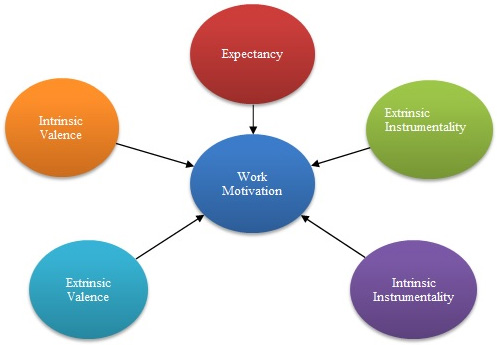
Research Hypotheses
The research proposes the following
hypotheses:
Expectancy (effort  performance):
performance):
If employees believe that putting
more effort into their job would lead
to better performance, then it is
logical to assume that in theory,
this perception would lead to increased
motivation. So we propose the first
hypothesis:
H1: Expectancy has a positive
effect on public sector employee motivation.
Extrinsic instrumentality (performance
 extrinsic reward):
extrinsic reward):
If employees believe that better performance
would lead to a desired extrinsic
reward, (promotion, bonuses, and better
salary) then it is logical to assume
that in theory, this perception would
lead to increased motivation. So we
propose the second hypothesis:
H2a: Extrinsic instrumentality
has a positive effect on public sector
employee motivation.
Intrinsic instrumentality (performance
 intrinsic reward):
intrinsic reward):
If employees believe that better performance
would lead to a desired intrinsic
reward (feeling of accomplishment,
more control over job, and more confidence),
then it is logical to assume that
in theory, this perception would lead
to increased motivation. So we propose
the third hypothesis:
H2b: Intrinsic instrumentality
has a positive effect on public sector
employee motivation.
Extrinsic valence (desired extrinsic
reward):
If employees place high value on a
desired extrinsic reward then it is
logical to assume that in theory,
this perception would lead to increased
motivation. So we propose the fourth
hypothesis:
H3a: Extrinsic valence has
a positive effect on public sector
employee motivation.
Intrinsic valence (desired intrinsic
reward):
If employees place high value on a
desired intrinsic reward then it is
logical to assume that in theory,
this perception would lead to increased
motivation. So we propose the fifth
and final hypothesis:
H3b: Intrinsic valence has
a positive effect on public sector
employee motivation.
Statistical methods used
For the purpose of descriptive and
statistical analysis required for
the research objectives, the following
statistical methods were used:
1. Frequency and percentages to describe
the characteristics of the sample.
2. The mean and standard deviation
3. Cronbach's Alpha to examine the
internal consistency estimate of reliability
of test results.
4. Pearson correlation coefficient
5. Multiple Regression Analysis (MRA).
Variable construction
Theoretical: Referring to researches
(previous literature), official government
reports, and government civil service
system guide.
Practical: Distribution of
a questionnaire (Chiang, 2008) that
includes a section for each element
of the adjusted expectancy theory
model. (See Table 1)
Table 1: Cronbach's Alpha Coefficient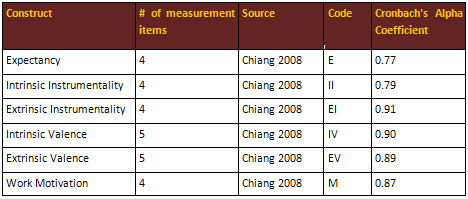
The research measurements were designed
using a 7-point Likert scale. The
Cronbach's Alpha Coefficient ranged
from (0.77 - 0.91) which is statistically
acceptable in managerial research
because it is larger than 0.75 (Nunnaly
& Bernstein, 1994). This indicates
that the measurements have internal
consistency.
Data Analysis
The methods of data collection and
statistical approaches used to analyze
the data are clarified in this section.
Descriptive analytical research methods
are used to analyze the collected
data due to the study questions, which
is to examine the 5 constructs of
the expectancy theory (expectancy,
extrinsic and intrinsic instrumentality,
and extrinsic and intrinsic valence)
and its relationship with employee
work competition.
The public sector in Jordan employs
approximately 225,000 employees. The
sample intended to represent a large
spectrum of employees, consisting
of 13 public sector institutions (The
Parliament, Ministry of Education,
Ministry of Interior, Ministry of
Environment, Ministry of Communication
and Information, Ministry of Planning
and International Cooperation, Natural
Resources Authority, Social Security
Corporation, Vocational Training Corporation,
Independent Commission for Elections,
Institution for Standards and Metrology,
Jordan Investment Board, Supreme Judge
Department, Health Insurance Department,
and Independent Election Commission).
The population is composed by employees
in the Jordanian public sector. The
sample consisted of 13 institutions,
300 questionnaires were distributed,
282 returned, and 258 were suitable
for data analysis. The gender ratio
was as follows: 56.2% consisted of
males and 43.8% of females. The age
of the sample ranged from 20 to 61
years old. The educational level variation
was as follows: 13.9% were at secondary
level, 14.3% held diploma, 52.3% Bachelors,
13.9% Master's, 5.4% PhD. (See Tables
2, 3, 4)
Table 2: Gender of the population

Table 3: Age group of the population
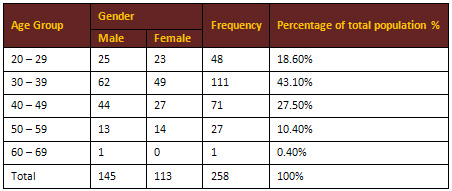
Table 4: Educational level of the
population
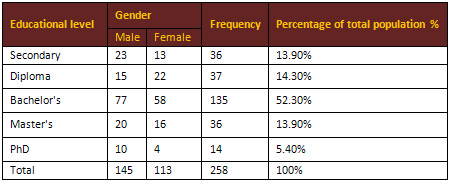
Results
We concluded the extent to which
each measurement item was perceived
by employees through calculating their
mean scores, which are presented in
Table 5. For the expectancy's four
measures, the mean scores ranged from
5.48 (more effort leads to being regarded
as an effective employee) to 5.88
(working hard will get the employee
more accomplished) based on the 7-point
Likert scale. The extrinsic instrumentality
ranged from 3.11 (performing well
gets pay increase) to 3.91 (performing
well gets more opportunities for promotion).
Intrinsic instrumentality had noticeably
higher mean scores, ranging from 5.47
(performing well leads to more responsibility
or control over job) to 5.96 (performing
well leads to a feeling of accomplishment).
When it came to valence, the mean
scores were somewhat similar to instrumentality,
with extrinsic valence ranging from
3.21 (performing well leads to a good
salary), to 4.61 (performing well
leads to interesting work), and intrinsic
valence ranging from 5.38 (performing
well results in more challenging tasks)
to 5.75 (performing well leads to
personal growth and development).
Work motivation achieved high mean
score with the lowest being 6.05 (a
tie between high motivation leading
to expending more effort on the job
and enhancing quality of performance)
and the highest being 6.07 (high motivation
leads to increased productivity on
the job). So in conclusion, respondents
evaluated intrinsic instrumentality
as the highest. With the high mean
scores for work motivation, employees
indicated that high motivation would
lead to improved performance.
Table 5: Descriptive statistics
of measurement items
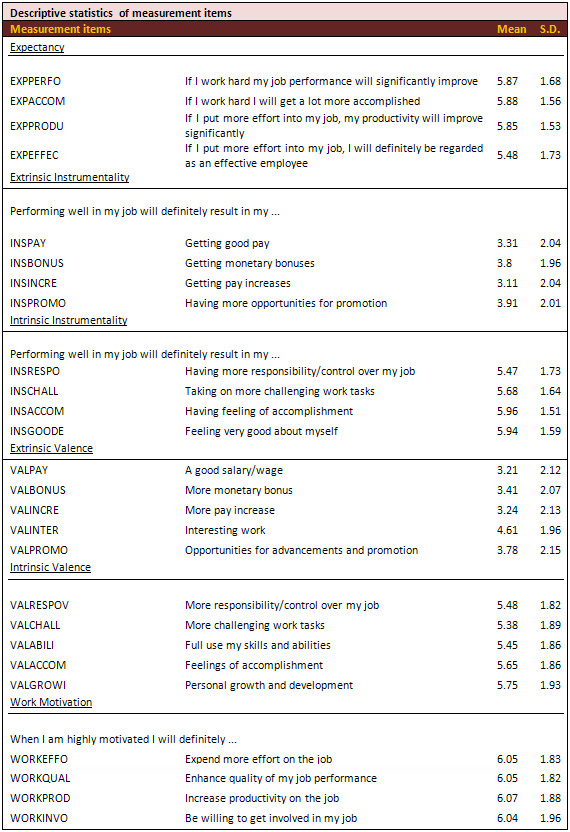
Note: A 7-point scale was used, from
1 (strongly disagree) to 7 (strongly
agree).
Table 6: Correlations
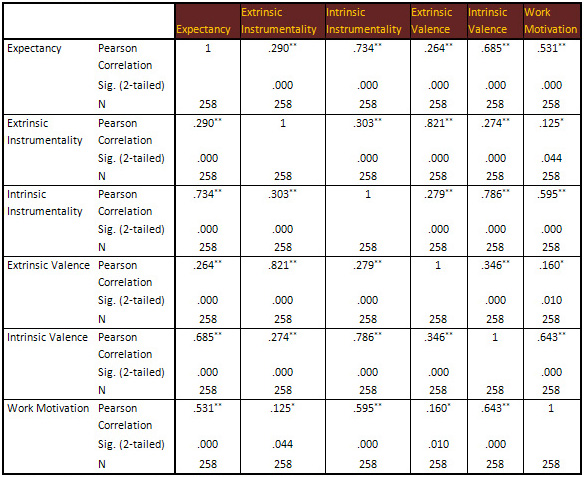
** Correlation is significant at the
0.01 level (2-tailed).
* Correlation is significant at the
0.05 level (2-tailed).
Table 7: Multiple Regression Analysis
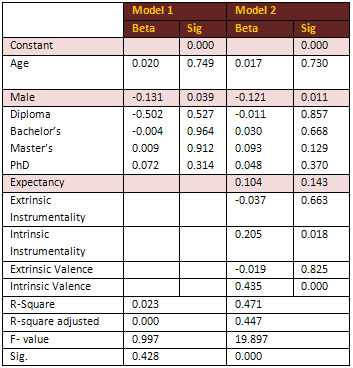
The modified expectancy theory model
is validated as R-squared was able
to explain more the more than 47%
of the variance of the work motivation.
The F-value (approximately 19.9) proves
the fit of the model.
The analysis shows that extrinsic
instrumentality and valence do not
have a significant impact on work
motivation (the significance level
is above 0.10). However, it is interesting
to see that despite not being statistically
significant, the relation is expected
to be negative (the beta coefficient
is negative). So, Jordanian public
employees are actually less motivated
when they receive more extrinsic rewards.
However, this statement needs to be
further tested in future research,
since there is no statistical support
for it in our study.
The intrinsic instrumentality and
valence are statistically and positively
related to work motivation, with a
level of significance of 0.024 and
less than 0.001, respectively. The
biggest impact is assigned to intrinsic
valence. Results show that employees
are motivated with the reward of feeling
of accomplishment and personal growth
and development, so they place great
value on intrinsic rewards.
Expectancy is not statistically significant
(near 0.10 but over this threshold).
However, the expected relation should
also be positive in this case (See
Table 7).
Table 8: Results of the modified
expectancy theory model
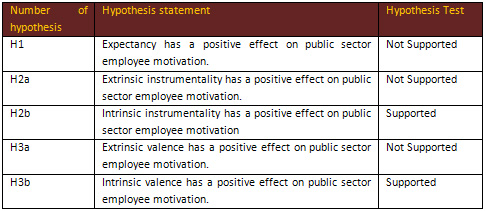
Table 9: ANOVAb

a. Predictors: (Constant), Expectancy
Extrinsic Instrumentality, Intrinsic
Instrumentality, Extrinsic Valence,
Intrinsic Valence
b. Dependent Variable: Work motivation
Limitations
and Recommendations
We encountered some limitations while
collecting the data. The first one
is that the data was only collected
from public sector institutions in
Amman, which is the developed capital
of the country, so it might not be
representative of all employees across
Jordan. The data was only collected
from administrative staff, so it might
not be a fair representation of the
different types of public sector employees.
The data was sometimes collected with
the supervision of a manager, which
might have influenced the answers
of the employees.
We recommend public sector institutions
to look further into why extrinsic
rewards (even with the latest reforms)
do not resonate with the employees
as to better understand how employee
work motivation functions. In this
way, further improvements could be
made to the system.
Expectancy is not significant but
is very close to become so. This gives
hope that maybe with more improvements
in the public sector, expectancy could
increase leading to better motivation
and thus better performance. The public
sector job is very routine-oriented
with little room for creativity and
better performance. Decreasing, when
possible, the mundane tasks could
lead to improvements.
Conclusion
The validity of the modified expectancy
theory model is supported in this
study. The modified model explains
the expectancy, extrinsic and intrinsic
instrumentality, and extrinsic and
intrinsic valence of employee motivation
in the public sector in Jordan.
The research showed that the intrinsic
instrumentality and valence factors
have a significant and positive relation
with work motivation. This is good
news for the public sector, because
intrinsic rewards are easier to capitalize
on since they do not require financial
resources to incorporate into the
work environment. Therefore, it clear
that the management must recognize
intrinsic rewards and include them
in their human resource strategies
as they are important motivators for
the employees. The managers should
support and encourage a work environment
where performance is verbally recognized
and friendly competition is fostered.
Recognition of the employees' effort
and performance contributes to the
feeling of accomplishment and self-worth.
It is also good to care about their
employees' own personal growth and
development which can be done through
training, workshops, and helping the
employees obtain certificates that
qualify them for career advancements.
As for the extrinsic elements (instrumentality
and valence), they do not contribute
to work motivation as much as intrinsic
elements do. However, the public service
system does in fact reward performance:
annual evaluations are taken into
consideration in upgrades based on
merit, which should motivate employees
to improve performance. With the recent
reforms, there is no longer a limit
to the times an employee can be upgraded
based on merit. Another amendment
rewards employees with an annual bonus
if they acquire a new qualification
such as a bachelor or a master's degree.
Another one uses negative rewards.
Now employment is by contracts, which
means if performance does not reach
certain standards the employee could
have disciplinary actions taken against
him/her and even possibly being fired.
This should decrease the feeling of
job security that sometimes leads
to lack of productivity.
The research contributes to the existing
literature by being the first one
to implement the expectancy theory
in the public sector in Jordan, proving
its validity.
It also comes at an important time;
three months after the latest civil
service system reforms. The research
explains the employees' view of the
system after the amendments and their
impact on work motivation. Further
research could examine the motivation
of employees in response to the civil
service system reforms, to see if
they are having the desired impact.
Further research could also delve
into how employees are motivated by
intrinsic rewards and how that could
be incorporated into the everyday
work life in the public sector. Since
expectancy is very close to becoming
significant, future research should
look into how the public sector job
could be improved so that employees
are more motivated to be performant.
References
Adamchik, V. A., & Bedi, A. S.
(2000). Wage differentials between
the public and the private sectors:
Evidence from an economy in transition.
Labor economics, 7(2), 203-224.
Baldwin, J. N. (1987). Public versus
private: Not that different, not that
consequential. Public Personnel Management,
16, 181-191.
Boudarbat, B. & Chernoff, V. (2009).
The determinants of Education-Job
Match among Canadian University Graduates.
IZA Working paper No. 4513.
Buelens, M., & Van den Broeck,
H. (2007). An analysis of differences
in work motivation between public
and private sector organizations.
Public Administration Review, 67(1),
65-74.
Campbell, J. P. & Pritchard, R.
D. (1976). Motivation Theory in Industry
and Organizational Psychology, in
Dunnette, M. D. (ed.) Handbook of
Industrial and Organizational Psychology,
Chicago: Rand McNally.
Chiang, C. F., & Jang, S. (2008).
An expectancy theory model for hotel
employee motivation. International
Journal of Hospitality Management,
27(2), 313-322.
Crewson, P. E. (1997). Public-service
motivation: Building empirical evidence
of incidence and effect. Journal of
Public Administration Research and
Theory, 7(4), 499-518.
Delfgaauw, J. & Dur, R. (2008).
Incentives and Workers' Motivation
in the Public Sector. The Economic
Journal, 118, 171-191.
Fudge, R. S., & Schlacter, J.
L. (1999). Motivating employees to
act ethically: An expectancy theory
approach. Journal of Business Ethics,
18(3), 295-304.
Gabris, G. T. & Simo, G. (1995).
Public sector motivation as an independent
variable affecting career decisions.
Public Personnel Management, 24(1),
33-51.
Graen, G. (1969). Instrumentality
theory of work motivation: some experimental
results and suggested modifications.
Journal of Applied Psychology, 53,
1.
Groeneveld, S., Steijn, B., &
Van der Parre, P. (2009). Joining
the Dutch Civil Service: Influencing
motives in a changing economic context.
Public Management Review, 11(2), 173-189.
Hammerschmid, G., Meyer, R. E. &
Demmke, C. (2007). Public Administration
Modernization: Common Reform Trends
or Different Paths and National Understandings
in the EU Countries. In: K.Schedler
&I. Proeller, I. (eds) Cultural
Aspects of Public Management Reform,
Emerald Group Publishing Limited,
pp. 145-169.
Houston, D. J. (2011). Implications
of occupational locus and focus for
public service motivation: Attitudes
toward work motives across nations.
Public Administration Review, 71(5),
761-771.
Landy, F. J., & Becker, W. S.
(1990). Motivation theory reconsidered.
In B. M. Staw & L. L. Cummings
(Eds.), Work in organizations (pp.
1-38). Greenwich, CT: JAI Press
Lawler III, E. E., & Suttle, J.
L. (1973). Expectancy theory and job
behavior. Organizational Behavior
and Human Performance, 9(3), 482-503.
Lawler, E. E. (1971). Pay and organizational
effectiveness: A psychological view.
New York: McGraw-Hill.
Lawler, E. E., & Porter, L. W.
(1967). The effect of performance
on job satisfaction. Industrial relations:
A journal of Economy and Society,
7(1), 20-28.
Perry, J. L., & Wise, L. R. (1990).
The motivational bases of public service.
Public Administration Review, 50(3),
367-373.
Schwab, D. P., Olian-Gottlieb, J.
D., & Heneman, H. G. (1979). Between-subjects
expectancy theory research: A statistical
review of studies predicting effort
and performance. Psychological Bulletin,
86(1), 139.
Solomon, E. E. (1986). Private and
public sector managers: An empirical
investigation of job characteristics
and organizational climate. Journal
of Applied Psychology, 71(2), 247.
Starke, F. A., & Behling, O. (1975).
A test of two postulates underlying
expectancy theory. Academy of Management
Journal, 18(4), 703-714.
Tansel, A. (2005) "Public?private
employment choice, wage differentials,
and gender in Turkey", Economic
Development and Cultural Change, 53(2),
453-477.
Van Eerde, W., & Thierry, H. (1996).
Vroom's expectancy models and work-related
criteria: A meta-analysis. Journal
of Applied Psychology, 81(5), 575.
Vroom, V. H. (1964). Work and Motivation.
New York: John Wiley & Sons.
Wittmer, D. (1991). Serving the people
or serving for pay: Reward preferences
among government, hybrid sector, and
business managers. Public Productivity
& Management Review, 369-383.
|